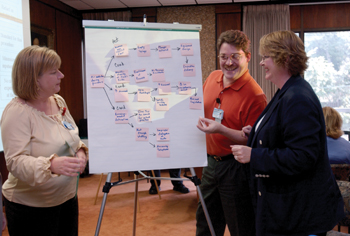
From left, Diane Johnson, manager of the Neuroscience patient care center, James Barnett, also with the Neuroscience patient care center, and Becky Keck, assistant hospital director, work together on cause and effect diagramming during a training session on Root Cause Analysis.
photo by Dana Johnson
Analysis process digs for roots of workplace errors
What could be more indispensable to a society than guilt and blame? On a normal day the two emotions act on most like a magic spell, preventing people from doing intentional harm to their neighbors or themselves.
But when the goal is understanding and preventing unintentional harm and error in a highly technical setting such as a large medical center, it turns out that blame becomes more of a group liability rather than an individual burden.
“A blame-free culture is the one indispensable attribute shared by the most safely run industries,” said F. Andrew Gaffney, M.D., chief quality and patient safety officer at Vanderbilt University Medical Center.
Blame, in and of itself, doesn't help solve an error, much less do anything to modify a process to reduce the risk of error in the future. That's where process-monitoring systems such as Root Cause Analysis (RCA) come in. RCA is a method for picking apart and understanding the causes of workplace errors, including safety lapses. Since 1996, the nation's leading health care accreditor has required that organizations perform root cause analysis of any event that, if repeated, would pose a significant risk of death or serious injury to a patient. These errors and lapses are called sentinel events. At VUMC, analysis of sentinel events is facilitated by Risk and Insurance Management.
For patient safety, VUMC is expanding the class of events that will trigger root cause analysis. The Medical Center has begun training representatives from patient care centers to perform RCA for less serious adverse events and near misses. Risk and Insurance Management will continue to facilitate RCA for sentinel events, said that office's associate director, Sandra H. Bledsoe.
RCA focuses on processes rather than individual performance, said Bobbie Sue Dietz, associate director for patient safety with Risk and Insurance Management and the Center for Clinical Improvement. Her team diagrams the steps leading to the event or near miss, taking into account surrounding circumstances, communication, the equipment used, and the applicable policies and procedures. The team identifies weaknesses and develops action plans to prevent recurrence.
“This level of analysis is universally present in high-reliability organizations where safety lapses are minimal,” Gaffney said. Nuclear power and aviation are among industries that have become safer because they’ve applied root cause analysis to events that threaten safety.
Gaffney said RCA stands in stark contrast to health care's traditional approach to unsafe events.
“If a patient were given the wrong drug, the old solution was to write up the nurse for failing to check the order,” Gaffney said, “but a root cause analysis might find that the patient had the same name as another patient, in which case you've now uncovered a problem with the system, a cause of harm that you can try to fix. The old thinking was to urge people to try harder and be more vigilant, but that never leads to significant improvement. Learning how to conduct a root cause analysis gives our staff a new way to look at how things are done in their units and recognize when a process can be made safer.”
Examples of near misses that will trigger a RCA by a VUMC patient care center might include a mistaken drug or radiology order, the wrong drug being delivered to a unit, or the wrong patient being sent for a procedure.
Near misses represent a still largely untapped opportunity for study and improvement, said John Bingham, director of the Center for Clinical Improvement. He noted that near misses are far more common than actual errors, they're free of hampering legal issues, and far less guilt hangs over the discussion of a near miss.
Reporting of near misses is itself something of a culture change, Gaffney said. VUMC does better than many other academic medical centers at reporting preventable adverse events and near misses, he said, but more progress is needed because the level of reporting is still nowhere near that found in commercial and military aviation and other high-reliability organizations. Reporting of near misses has been widely encouraged at VUMC since the installation early last year of VERITAS, Vanderbilt's electronic patient safety reporting system.













